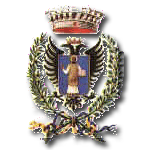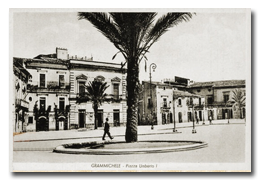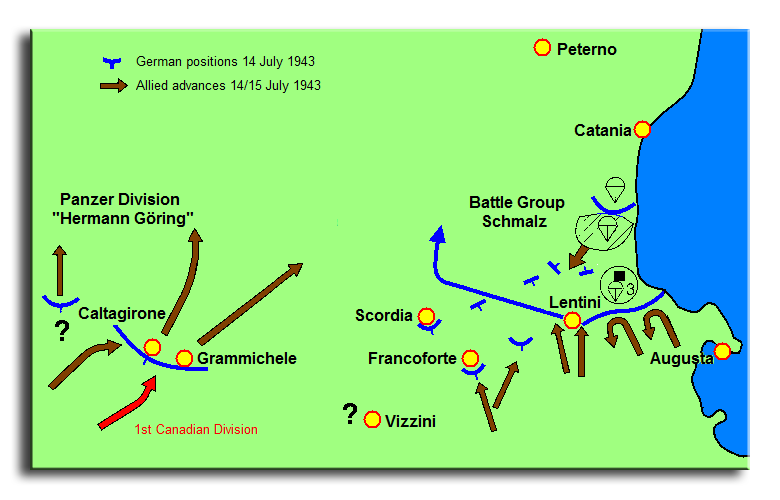
 Translate
Translate
-
* News
- - Agira 2018, 75 years later
- - Agira 2013, 70 years later
- - Gallery of ceremony 2013
- - Operation Husky 2013
- * Students' Contribute
- * About Us
- * Visitor's Book
- * Collaborators
- * Canadian Battles
- * Italian Defensive Positions
- * Allied Forces
- * Historical Movies
- Historical Information
- Historical Maps
- * Bibliography
- Biographies
- * Catania War Cemetery
- * Moro River War Cemetery
- * Syracuse War Cemetery




Grammichele was a Battle Honour granted to Canadian regiments that fought at that town during the Battle of Sicily, a phase of the Italian Campaign during the Second World War.
 The 1st Canadian Division had landed on Sicily on 10 July and due to the weakness of the opposition, coupled with a high state of training and individual physical conditioning, had performed well. The division, despite challenges in acclimating to the tropical conditions, as well as shortages of motor transport, had advanced 30 miles as the crow flies in three days and collected hundreds of Italian prisoners. The "breaking in" period was capped by an administrative pause at Giaarratana. However, apart from a handful of German Air Force personnel captured in the opening hours of the landing, the Canadians had yet to meet soldiers of the German armed forces in battle on Sicily.
The 1st Canadian Division had landed on Sicily on 10 July and due to the weakness of the opposition, coupled with a high state of training and individual physical conditioning, had performed well. The division, despite challenges in acclimating to the tropical conditions, as well as shortages of motor transport, had advanced 30 miles as the crow flies in three days and collected hundreds of Italian prisoners. The "breaking in" period was capped by an administrative pause at Giaarratana. However, apart from a handful of German Air Force personnel captured in the opening hours of the landing, the Canadians had yet to meet soldiers of the German armed forces in battle on Sicily.
In the late hours of 13 July, the third phase of the operations forecast laid out by General Alexander, the commander of 15th Army Group, was complete, in that a firm base to ensure the capture of Catania and a cluster of airfields at Gerbini had been established. Major counter-attacks were pressing only against the Americans, firmly established on their beaches. The next major objective to be gained was Enna, with the purpose of splitting the island in two and disrupting enemy east-west communications.
A decision to send the 30th Corps towards Enna meant redefining the boundary between the U.S. 7th and British 8th Armies, and Highways 124 and 117 were reassigned from the Americans to the British, with the American axis of advance turned west. The 30th Corps was ordered to advanced through Leonforte and Enna towards San Stefano, with the 23rd Armoured Brigade leading. The general plan was to capture Vizzini on 12 July, take Calatagirone on the next night, and then advance on Enna on 14 July. The 51st (Highland) Division was to start by advancing the right flank of the corps towards Scordia and cleaning up the area around Vizzini. In the event, though, Vizzini remained in German and Italian hands until the 14th, the plan to send the 23rd Armoured Brigade to Caltagirone was scratched, and the 1st Canadian Division, instead of holding between Ragusa and Vizzini, was ordered through Vizzini to advance on Enna.1
The Hermann Göring Division, one of the best equipped armoured divisions in the German military (possessing, among other things, an organic unit of Panzerkampfwagen VI "Tiger" tanks), was concentrated in the Caltagirone area on D-Day, with a battle group (Kampfgruppe Schmalz) detached to the west in the Catania area. Italian plans for the defence of the island had centred on the notion of withdrawing to the interior of the island following enemy invasion, to defend a "triangle" of territory in the centre of the mountainous highlands, making use of short interior lines, acknowledging the weak coastal defences and shortages of troops necessary to garrison the entire island. The Germans, for their part, had wanted to position both the 15th Panzer Grenadier and Hermann Göring divisions directly on the likeliest invasion sites ready to counterattack enemy landings. The Italians agreed in principle, but when it came time to fight in places like Syracuse and Augusta, Italian divisions necessary to the German defence of those sectors were found to have disappeared - withdrawn to the "inner triangle" of their earlier plans.2
 The road into Grammichele ran through a wide valley, free of houses, with large fields that had been denuded of trees and rocks over centuries. Grammichele itself was ten miles from Vizzini and home to 13,000 people, many farmers from the surrounding fields who preferred to live in the hilltop towns rather than in the valleys. The town dated to 1683 and was built on a hexagonal plan radiating from a central square, on a hill 250 feet above the surrounding countryside and commanding the road approaching from the east. The Canadian column rounded a bend in the road and first came into view two miles away at 0900.
The road into Grammichele ran through a wide valley, free of houses, with large fields that had been denuded of trees and rocks over centuries. Grammichele itself was ten miles from Vizzini and home to 13,000 people, many farmers from the surrounding fields who preferred to live in the hilltop towns rather than in the valleys. The town dated to 1683 and was built on a hexagonal plan radiating from a central square, on a hill 250 feet above the surrounding countryside and commanding the road approaching from the east. The Canadian column rounded a bend in the road and first came into view two miles away at 0900.
Reconnaissance vehicles of the Three Rivers approached the town with the Hastings and Prince Edward Regiment close behind; German weapons firing from ambush quickly knocked out a Sherman tank and three universal carriers as well as several other vehicles. Self-propelled guns of the Devon Yeomanry deployed off the road and into the fields to bring fire onto the town while the Hastings' infantry reacted, sending three companies into the town from three different directions while a carrier forward marked positions with tracer fire for tanks of the Three Rivers Regiment, which eventually knocked out three German tanks and some self-propelled flak guns.
The Hermann Görings began to evacuate as the lead Canadian infantrymen appeared in their perimeter, and by noon the town was firmly in Canadian hands. The enemy had left behind a large number of stores as they withdrew to the west; the battle had cost the Canadians 25 casualties.3
The 48th Highlanders, using carriers provided by the Saskatoon Light Infantry, gave chase with tanks in support, but a mined road slowed their progress, and they did not reach Caltagirone until midnight, having dismounted along the way. They entered the town early on 16 July to find the former headquarters of the Hermann Göring Division heavily damaged by Allied bombs.
In the meantime, the 2nd Brigade had left Ragusa late on the 14th, with only enough tranport to move one battalion by vehicle. As the Loyal Edmonton Regiment, with Brigade Headquarters, rode to Vizzini, PPCLI and the Seaforths were left to march over 30 miles in extreme heat.
The Germans, for their part, were conscious of the failings of the Italians to carry their share of the load in the fighting, and were shifting their forces to the east to prevent a drive towards the ferry crossings at Messina, which would trap substantial forces on Sicily. The Hermann Göring disengaged from the Vizzini-Caltagirone area and moved to the assistance of Battle Group Schmalz at Lentini. In the words of their history:
The Italian troops had, as far as the Schmalz Brigade could determine, left their positions in the coastal area, even where they weren't being attacked. As a result the entire coast was denuded of troops and left open to seizure by the enemy. The Schmalz Brigade was left alone on a broad stage, its rear and flanks completely unprotected...If the attack succeeded, all German-Italian units on the island would be cut off from their lifeline across the Strait of Messina...
The completely open Catania Plain remained (Schmalz's) main concern. If the plain was lost, a defence of Malleoli and Lentini would be pointless.4
The Napoli Division joined the Hermann Görings, having suffered the most of the Italian regular divisions so far in the invasion. The 15th Panzer Grenadier Division was recalled hastily from a redeployment to the west of the island, to position itself on the flank of the HG Division and the Italian Livorno Division settled in the gap between them. Further withdrawals toward Mount Etna tightened up positions, but there was no real defensive line to fall back on such as would later be encountered in Italy. The HG began a six-day series of withdrawals to a line running from Catenanuoa-Catania following the Dittaino River. Hilltop towns now became vital, and commanding positions at Caltagirone, Piazza Amerina, Valguarnera, Enna and Leonforte overlooking lateral roads leading to the east onto the Catania plain. Towns became strongpoints as the HG sought to hold off the thread of encirclement.
Special forces were brought in to continue the advance of 13th Corps along the coast, meeting strong opposition; No. 3 Commando landed from the sea at Catania to secure a bridge on the Syracuse-Catania highway, and the 1st Parachute Brigade dropped at the Primosole Bridge six miles south of Catania; troops of the 50th Division driving to link up met fierce opposition. The Canadians were urged to keep pushing hard on the left flank, and so it was that the 1st Canadian Division was urged on again towards Enna.
The following Canadian units were awarded the Battle Honour "Grammichele" for participation in these actions:
 1st Canadian Armoured Brigade
1st Canadian Armoured Brigade
-
12th Canadian Armoured Regiment (The Three Rivers Regiment)
 1st Canadian Brigade
1st Canadian Brigade
-
The Hastings and Prince Edward Regiment
Notes
-
Nicholson, Gerald Official History of the Canadian Army in the Second World War: Volume II: The Canadians in Italy
-
Kurowski, Franz The History of the Fallschirmpanzerkorps Hermann Göring (Soldiers of the Reichsmarschall) (English translation by J.J. Fedorowicz Publishing Inc., Winnipeg, MB, 1995) ISBN 0-921991-25-8 pp.139-151
-
Nicholson, Ibid
-
Kurowski, Ibid, p.152



